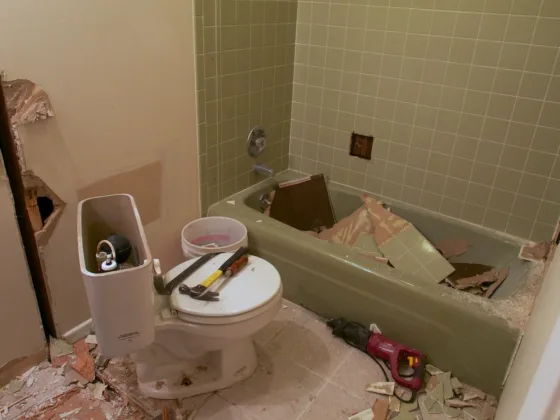Structural damage is considered as the most expensive of all home repairs. It’s defined as any damage inflicted on the core area of your home’s structure.
This includes the roof, walls, foundation, and load-bearing walls. When structural damage occurs, your home will be at risk of falling apart.

This type of damage is commonly caused by high winds, but strong floods are also known to result in damage to a house’s structural design.
Windstorms and flood damage can cause metal fasteners to fail and 2×4 wall frames to give way, leading to home collapse.
Anything that causes damage to the support structure of your property can be dangerous. Plumbing issues can start to develop, notably leaks, that can cause corrosion and weakness to the foundation’s metal structures.
Signs That Your House Has Structural Damage
It doesn’t matter what the cause is, it’s important that you restore your home after it incurs damage. Below are the signs that your home has been damaged structurally and is in need of repair:
1. Wall and Ceiling Cracks
To clarify, not all cracks showing on your ceiling and walls are definite signs of structural damage. Still, it is important that you keep an eye out for them because they
can become a serious problem over time. On the other hand, a large crack paired with a sagging roof is an indication of a bigger problem.
2. Soil Pulling of House Walls
The seasons change the way soil expands and contracts. Check the soil that surrounds your house, especially the porch or the patio area. If you notice signs of movement away from their original position, you might want to have the foundation of your home checked.
Read Also:
3. Chimney Cracks
These can be easily seen even from outside the house. Chimney cracks, just like those found in the exterior walls, are indications that your home may be shifting.
4. Uneven Window and Door Gaps
Because of the holes cut into their walls, windows and doors become more susceptible to pressure and will either not open and close easily, will not lock correctly, and in the worst-case scenario, get completely separated from the walls.
5. Sagging Roof
A sagging roof could mean that the foundation has been damaged by floodwaters but it could also be a sign that your roof has problems.
Among other things, sagging roofs could also be the result of termite infestation, poor maintenance, and timber frame movement.
6. Damp Subflooring
Prolonged exposure to floodwaters can lead to wet or damp subflooring. The floor timbers will then become susceptible to rotting and you should easily notice significant surface stains.
7. Sagging, Sloping, or Cracking Floors
When inspecting your flooring for signs of cracking, sloping, or sagging, you will notice shifts or movements in the foundation of your home. If the movements are significant, it means a serious imperfection has developed in your home’s structural design.
8. Crumbling Concrete/Brick
Although this is not a common occurrence, there will be instances when concrete will erode if it comes into contact with chemicals and high moisture.
Concrete can crack due to chemical reactions that break up the bond which keeps the materials together. This is most often visible in the brickwork built just beneath the waterproofing portion of your house.
Restoration Experts and Structural Damage
Water damage is a matter of urgency, especially if they have caused significant ruin to the structural design of your home. Restoration professionals can handle this type of job effectively.
Below are some of the benefits you can gain when specialists begin restoring your home that has suffered structural damage:
1. Complete Restoration
Experts are not only concerned about inspecting any structural damage your home has incurred; they will also work on providing you with a complete restoration service.
Their immediate focus will be on drying up the area using specialized tools and equipment like air filters, vacuums, vacuums pumps, and extraction tools.
2. Saving Your Belongings
While saving the structure of your home is their priority, restoration professionals are also aware that some possessions have sentimental value. Thus, you can count on them to work on salvaging your valuable items.
3. Client Protection
Water damage repair is a complex and dangerous process as there are many dangers hiding in the waters. Experts are committed to keeping you safe from all of these hazards by initially shutting down electricity sources, inspecting possible gas leaks, and stabilizing your property.
The next process will be to remove all bacteria and viruses that might be clinging on to your house and furnishings.
4. Assistance for Insurance Claims
It can be difficult to file insurance claims after a home has been damaged by water. Flood restoration professionals can help you document the incident, including your losses, and help you negotiate a fair settlement from your insurance company.
5. Experience and Expertise
The years of experience and expertise that restoration companies have in handling water damage to properties is a testament to their ability to handle the job efficiently.
They are duly certified and have the training and tools to manage complex and basic restoration works.
Key Takeaway
Destroying the structural foundation of your home is just one of the many adverse effects of water damage. Nevertheless, it’s one major problem that should be resolved right away because not doing so can lead to the entire house falling apart.
Restoration costs for homes devastated structurally are hardly inexpensive, but a Dallas water damage restoration professional can discuss with you several options. In the end, you can have your original home restored as new.










